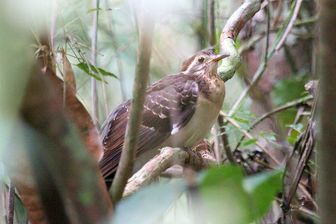Pheasant Cuckoo

Original source: Dominic SheronyPermission(Reusing this file)This image, which was originally posted to Flickr.com, was uploaded to Commons using Flickr upload bot on 20:35, 21 April 2010 (UTC) by Howcheng (talk). On that date it was licensed under the license below. This file is licensed under the Creative Commons Attribution-Share Alike 2.0 Generic license.You are free:to share – to copy, distribute and transmit the work
Author: Dominic SheronyPermission(Reusing this file)This image, which was originally posted to Flickr.com, was uploaded to Commons using Flickr upload bot on 20:35, 21 April 2010 (UTC) by Howcheng (talk). On that date it was licensed under the license below. This file is licensed under the Creative Commons Attribution-Share Alike 2.0 Generic license.You are free:to share – to copy, distribute and transmit the work
The Pheasant Cuckoo is classified as Least Concern. Does not qualify for a more at risk category. Widespread and abundant taxa are included in this category.
The Pheasant Cuckoo (Dromococcyx phasianellus) is a species of cuckoo in the Cuculidae family. It is found in Argentina, Belize, Bolivia, Brazil, Colombia, Costa Rica, Ecuador, El Salvador, French Guiana, Guatemala, Guyana, Honduras, Mexico, Nicaragua, Panama, Paraguay, Peru, Suriname, and Venezuela. Its natural habitats are subtropical or tropical dry forests, subtropical or tropical moist lowland forests, and subtropical or tropical swamps. References - * BirdLife International 2004. Dromococcyx phasianellus. More
The Pheasant Cuckoo is a medium-sized cuckoo found in forests throughout much of Central and South America. This species is known to be brood parasite, laying its eggs in the nests of other species; otherwise very little is known of it biology. The Pheasant Cuckoo first was suspected to be brood parasitic by von Ihering (1914a, 1914b), who reported on a strange egg in a nest of the Black-backed Water-Tyrant (Fluvicola albiventer) collected in November 1913 in Bahia, Brazil. More
Search for pheasant cuckoo at other dictionaries: OneLook, Answers. More
Cite This Source Search another word or see pheasant cuckoo on Thesaurus | Reference FacebookTwitterFollow us: About · Privacy Policy · Terms of Use · API · Careers · Advertise with Us · Link to Us · Contact Us Dictionary.com, LLC. Copyright © 2010. All rights reserved. More
Pheasant Cuckoo is a large cuckoo. It has a long graduated tail and a short crest. It is dark brown above; the underparts are paler, but the throat and breast are marked with dusky. Similar Species The Pavonine Cuckoo Dromococcyx pavoninus is similar but is smaller overall and has narrower rectrices. The throat and the breast of the Pheasant Cuckoo are heavily marked, whereas the throat and breast of the Pavonine Cuckoo are unspotted. More
stomach contents, Sick (1953) suggested that Pheasant Cuckoos obtain arthropod and small vertebrate prey from leaf litter on the forest floor. Sick also noted that Pheasant Cuckoo foraging behavior had never been described. I confirm Sick's speculation with a detailed account of the foraging technique used by D. phasianellus while searching for prey on the ground. The basic maneuver is of particular interest as it involves both sounds and feather movements that may flush prey from cover, thereby increasing feeding efficiency. More
The Pheasant Cuckoo is normally very hard to see but this bird had somehow landed in a lake where it was rescued by some concerned bird watchers. It spent an entire day recovering in a sheltered spot and then returned to the wild. More
Rezultati za: pheasant cuckooPrijevodi 1 - 5 of 5 Engleski Engleski Hrvatski Hrvatski pheasant fazan cuckoo kukati cuckoo kukavica great spotted cuckoo afrička kukavica great spotted cuckoo ćubasta kukavica Vrijeme pretrage: 0.001 sec. More
Family : Cuculidae
Genus : Dromococcyx
Species : phasianellus
Authority : (Spix, 1824)

